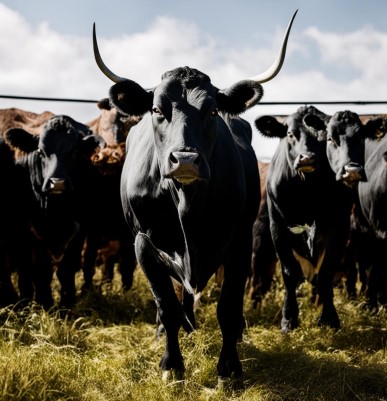Canadian Cattle Market Shows Strong Demand Early in 2024

“Livestock prices and futures prices tend to move in a similar pattern,” said Ann Boyda, Alberta livestock market analyst. “This correlation between the two markets adds value to the role of futures markets in managing price risk.”
Price quotes in the commodity futures market reflect the collective opinion of many traders regarding upcoming supply and demand conditions. it is often called the "benchmark" market. The basis is the difference between the cash price and the futures price.
Cash Market Price – Futures Market Price = Basis
The basis can be positive or negative. A negative basis implies that the local cash price is lower than the futures market price; Conversely, a positive basis means that the cash price is higher than the futures market price, or trading at a premium to the futures.
“Typically, cash prices are more volatile than the basis,” explains Boyda. “Historical information can help provide estimates for price forecasting. The volume of feed and live cattle is not constant throughout the year due to the seasonality of production. For example, since most of the cow herd is in spring calving, the largest supply of weaned calves occurs in the fall, ready for slaughter the following summer. Thus, feeder cattle numbers are strongest in the spring and tend to be weaker in the fall and early winter, while live cattle numbers are highest in the spring and summer. Historical baselines can be used as an indicator to predict future baselines.”
Much of the market's volatility has been driven by news of bird flu cases in dairy herds, which has left many feeling the beef sector is at risk. No viruses have been detected in MEAT, and no highly pathogenic avian influenza (HPAI) has been detected in beef, even in herds near dairy cows. Recent prices in the futures market seem to confirm the de-risking and are showing signs of recovery.
The covid-19 pandemic caused disruption in cattle markets in 2020 due to the closure of packing plants and the resulting supply chain impacts. Feeder cattle prices hit record levels in 2023, but live cattle futures declined in November and December, contributing to market fluctuations.
“The recent volatility is due to risks to consumer demand due to the discovery of avian influenza in dairy cattle,” says Boyda. “USDA's surveillance eases some concerns. On May 1, 2024 , the U.S. Department of Agriculture's Food Safety and Inspection Service (FSIS) announced the results of its testing of retail ground beef. FSIS collected 30 ground beef samples from retail outlets in states with dairy cattle herds that tested positive for the H5N1 influenza virus. All samples tested negative.”
“Seasonal trends are generally a reliable forecasting tool, but volatility in futures markets exposes vulnerabilities. The cattle market has seen strong demand in the early months of 2024 and, coupled with low cow numbers, the feed market should remain strong as feedlot operators look to maintain capacity,” says Boyda.
Read together with it:
- An HSE expert reported on the "evolution of inequality" in access to healthcare.An HSE researcher analyzed Russians' access to healthcare over a ten-year period. In 2021, the influence of financial factors became noticeable for the first time: low income reduces the likelihood of visiting a DOCTOR.Over the ten years from 2011 to 2021, the number of Russians requiring medical care but not receiving it remained virtually unchanged, according to a study by Lyudmila Zasimova, hea...
- Belstat reported how much grain, milk, meat, and vegetables are produced in Belarus per capita.November 14, MINSK . Belarus produces 913 kg of grain, 958 kg of MILK, 341 kg of potatoes, and 304 kg of vegetables per capita, according to a review by the National Statistical Committee for the Day of Agricultural and Processing Industry Workers, BELTA reports. The country also produces 78 kg of fruits and berries, 147 kg of livestock and poultry (slaughter weight), and 4......
- The IEA sees a risk of a decline in oil production in Russia due to sanctions.The IEA sees a risk of reduced oil production in RUSSIA due to US sanctions , but maintains its production forecast. According to the IEA, Russian oil exports will remain unchanged.There is a "significant downside risk" to Russia's oil production forecast due to US sanctions, the International Energy Agency (IEA) said in a report.BLOOMBERG . The agency's experts believe that the latest US sanction...
- UniCredit заявил о галактических усилиях из-за санкций против РоссииUniCredit старается не нарушить «более 15 тыс. санкций», а также не «совершать ошибки», которые позволят изъять его активы в России, заявил гендиректор. После начала военной операции банк начал рассматривать возможность ухода Итальянский банк UniCredit прилагает «галактические усилия», пытаясь соблюсти международные санкции в отношении своего российского подразделения. Об этом заявил генеральный д...
- Низкое предложение и устойчивый спрос: в Аргентине растут цены на мясоЦены на говядину снова выросли, что отразилось на полках супермаркетов и в мясных магазинах. За последние две недели розничные цены выросли на 8–12%, а на некоторые популярные отрубы рост превысил 15% по сравнению с октябрем. Тем не менее, продажи остаются высокими: потребители продолжают покупать, принимая новые цены и закрепляя тенденцию, которая повторяется каждый год в конце года, когда спрос ...


